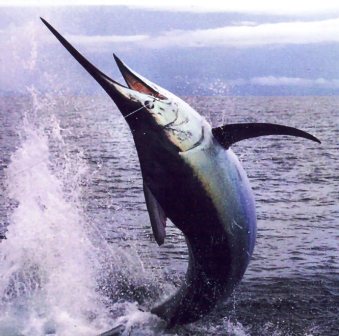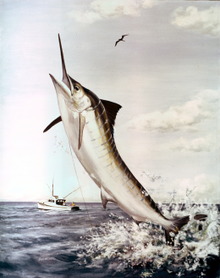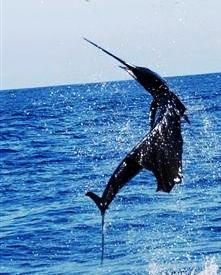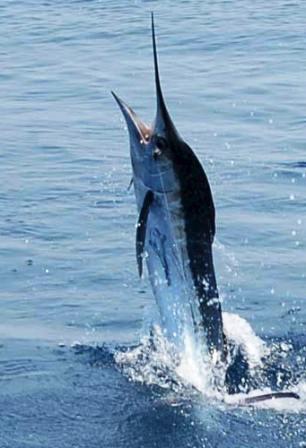Discover Florida Nature
It's time to explore the natural Florida


|
|
|
|
|
Billfish are
predatory fish that are distinguished by their long bill which
may seem more suited for a bird than a fish. These marine fish are found
off the coast of Florida and are cherished as a great sporting fish to
catch. There are numerous types of bill fish found off the coast of
Florida including the blue marlin, the longbill spearfish, the sailfish,
and the lesser known white marlin.  Blue
Marlin
(Makaira nigricans) Occurring offshore in blue oceanic
waters, the blue marlin prefers to stay in the warm waters near the
surface, above the thermocline. They follow the seasonal water
temperature changes, being closely tied to these warm waters. Blue
Marlin are found in ocean waters great distances from the continents as
well as coastal regions near deep waters, such as near the Mississippi
River in the Gulf of Mexico. The blue marlin is the largest billfish.
The upper jaw forms a large bill. The body is cylindrical from anal fin
forward. Two dorsal fins are present; the first dorsal fin is high and
slopes steeply posteriorly, while the second is small. The caudal
peduncle has keels. The lateral line forms a large net-like pattern of
hexagons canvassing the sides of the fish. The pelvic fins are slender.
The lateral keels on the caudal peduncle assist in making this fish a
powerful swimmer of great speed and stamina. Grooves for the pelvic fins
improve hydrodynamics. The blue marlin can reach a length of 14 feet
(4.3 m) and a weight of one ton (910 kg). Females are generally much
larger than males. Blue marlins prey on pelagic fishes including the
dolphin, mackerels, and tunas. Predators of the blue marlin include the
white shark. The blue marlin is an important game fish. Blue marlin are
greatly coveted by sportsfishers and trophy hunters. The presence of
this species in the waters offshore of a number of developing countries
provides important economic benefit to such areas. The blue marlin's
flesh is served raw and is a popular sushi fish in Japan, and is popular
table fare in some Pacific islands such as Hawaii. Blue
Marlin
(Makaira nigricans) Occurring offshore in blue oceanic
waters, the blue marlin prefers to stay in the warm waters near the
surface, above the thermocline. They follow the seasonal water
temperature changes, being closely tied to these warm waters. Blue
Marlin are found in ocean waters great distances from the continents as
well as coastal regions near deep waters, such as near the Mississippi
River in the Gulf of Mexico. The blue marlin is the largest billfish.
The upper jaw forms a large bill. The body is cylindrical from anal fin
forward. Two dorsal fins are present; the first dorsal fin is high and
slopes steeply posteriorly, while the second is small. The caudal
peduncle has keels. The lateral line forms a large net-like pattern of
hexagons canvassing the sides of the fish. The pelvic fins are slender.
The lateral keels on the caudal peduncle assist in making this fish a
powerful swimmer of great speed and stamina. Grooves for the pelvic fins
improve hydrodynamics. The blue marlin can reach a length of 14 feet
(4.3 m) and a weight of one ton (910 kg). Females are generally much
larger than males. Blue marlins prey on pelagic fishes including the
dolphin, mackerels, and tunas. Predators of the blue marlin include the
white shark. The blue marlin is an important game fish. Blue marlin are
greatly coveted by sportsfishers and trophy hunters. The presence of
this species in the waters offshore of a number of developing countries
provides important economic benefit to such areas. The blue marlin's
flesh is served raw and is a popular sushi fish in Japan, and is popular
table fare in some Pacific islands such as Hawaii.  Longbill
Spearfish
(Tetrapturuspfluegeri) Longbill Spearfish are similar
to other billfish but can be readily identified by the fin that is
similar to that of a marlin but is much higher throughout its length.
That coupled with a long bill differentiates it from all of the marlins
and the shortbill spearfish. The color of the longbill spearfish body is
dark blue shading to a silvery color, with white underneath. It has two
dorsal fins the first and main dorsal fin being long with a point at the
front. This dorsal fin is usually blue in color. The second dorsal fin
is much smaller and to the rear. The upper jaw is prolonged into a
spear, its cross section round. Longbill Spearfish are found in offshore
waters. They reach weights of 70 pounds. Longbill spearfish are short
lived bill fish that feed in offshore waters near the surface where they
dine on small fish and squid. Available data indicate that spearfish
matures at 2 years of age and rarely lives past 4 to 5 years. This
billfish is a lot smaller than the blue marlin and the white marlin. Longbill
Spearfish
(Tetrapturuspfluegeri) Longbill Spearfish are similar
to other billfish but can be readily identified by the fin that is
similar to that of a marlin but is much higher throughout its length.
That coupled with a long bill differentiates it from all of the marlins
and the shortbill spearfish. The color of the longbill spearfish body is
dark blue shading to a silvery color, with white underneath. It has two
dorsal fins the first and main dorsal fin being long with a point at the
front. This dorsal fin is usually blue in color. The second dorsal fin
is much smaller and to the rear. The upper jaw is prolonged into a
spear, its cross section round. Longbill Spearfish are found in offshore
waters. They reach weights of 70 pounds. Longbill spearfish are short
lived bill fish that feed in offshore waters near the surface where they
dine on small fish and squid. Available data indicate that spearfish
matures at 2 years of age and rarely lives past 4 to 5 years. This
billfish is a lot smaller than the blue marlin and the white marlin.  Sailfish
(Istiophorus platypterus) Marathon, a well known Florida game
and fish resort is also a popular area for the sailfish. Often found in
the Atlantic close to the Gulf Stream the sailfish is easily identified
by its large sail shaped front dorsal fin which is very large compared
to similar fish such as white marlin or longbills. The large blue dorsal
fin is a rich blue covered with black spots and is square and upright at
the front end. The body of the sailfish is a deep blue on top with a
blue/brown stripe along the center line of the body. The bottom half of
the body is silver to white. Like the other Florida game and fish such
as the blue marlin and white marlin the sailfish also has an extended
upper jaw shaped like a spear. Florida marlin fishing boats located in
the south of Florida near the Gulf Stream will often catch sailfish as
they like to feed on or near the surface eating squid and other pelagic
fish. They grow to 7 feet and are therefore considered a worthy trophy
by Florida game and fish sportsmen. Generally speaking the larger
catches are the females. The sailfish is a rapid swimmer and anyone who
has gone to Florida marlin fishing will know when they have one of these
on the end of the line as they can reach speeds of 40-50 knots! Spawning
is thought to be in the warmer summer months in water that is fairly
shallow, where mating males and females will swim side by side.
Sometimes a group of 2 or 3 males will stalk a female. These little ones
grow fast attaining a length of 48" to 60" in the first year of life. Sailfish
(Istiophorus platypterus) Marathon, a well known Florida game
and fish resort is also a popular area for the sailfish. Often found in
the Atlantic close to the Gulf Stream the sailfish is easily identified
by its large sail shaped front dorsal fin which is very large compared
to similar fish such as white marlin or longbills. The large blue dorsal
fin is a rich blue covered with black spots and is square and upright at
the front end. The body of the sailfish is a deep blue on top with a
blue/brown stripe along the center line of the body. The bottom half of
the body is silver to white. Like the other Florida game and fish such
as the blue marlin and white marlin the sailfish also has an extended
upper jaw shaped like a spear. Florida marlin fishing boats located in
the south of Florida near the Gulf Stream will often catch sailfish as
they like to feed on or near the surface eating squid and other pelagic
fish. They grow to 7 feet and are therefore considered a worthy trophy
by Florida game and fish sportsmen. Generally speaking the larger
catches are the females. The sailfish is a rapid swimmer and anyone who
has gone to Florida marlin fishing will know when they have one of these
on the end of the line as they can reach speeds of 40-50 knots! Spawning
is thought to be in the warmer summer months in water that is fairly
shallow, where mating males and females will swim side by side.
Sometimes a group of 2 or 3 males will stalk a female. These little ones
grow fast attaining a length of 48" to 60" in the first year of life. White
Marlin (Tetrapterus albidus) These exciting fish are
the smallest of the billfishes with a maximum length of 110 inches and
weighing in the region of 180 pounds. This beautiful fish has a long,
compressed and fusiform body. Its top jaw is twice as long as its bottom
jaw producing the bill which is round in cross section and compared to
other billfish, soft. The body has a dense covering of bony scales. The
lateral line runs straight along the body, with a single curve over the
origin of the dorsal fin. This billfish is very similar to the blue
marlin, and can be differentiated based on fin morphology. The white
marlin has a rounded dorsal fin at the front end, a rounded tip on the
pectoral and anal fins, and spots on the dorsal fin, while the blue
marlin has pointed dorsal, pectoral, and anal fins and no spots on the
dorsal fin. They are often associated with upwellings and weed lines,
and frequent regions with benthic geographic features such as drop-offs,
canyons, and shoals. White marlins do not tend to travel in schools, but
are usually observed swimming alone or in pairs. White marlin appear to
be sight-oriented, daytime feeders. An important prey item for white
marlin is squid. Bony fishes, especially dolphins,
blue runner,
mackerels, flying fish, and bonito
are also commonly eaten. Round herring, which are abundant along the
central Atlantic coast, are commonly consumed in that region. When
fishing for these fish they are normally found close to the surface and
can often be seen tail-walking (only the top of the tail is seen above
the surface). Ferocious when caught these fish will leap clean out of
the water when trying to free themselves. White
Marlin (Tetrapterus albidus) These exciting fish are
the smallest of the billfishes with a maximum length of 110 inches and
weighing in the region of 180 pounds. This beautiful fish has a long,
compressed and fusiform body. Its top jaw is twice as long as its bottom
jaw producing the bill which is round in cross section and compared to
other billfish, soft. The body has a dense covering of bony scales. The
lateral line runs straight along the body, with a single curve over the
origin of the dorsal fin. This billfish is very similar to the blue
marlin, and can be differentiated based on fin morphology. The white
marlin has a rounded dorsal fin at the front end, a rounded tip on the
pectoral and anal fins, and spots on the dorsal fin, while the blue
marlin has pointed dorsal, pectoral, and anal fins and no spots on the
dorsal fin. They are often associated with upwellings and weed lines,
and frequent regions with benthic geographic features such as drop-offs,
canyons, and shoals. White marlins do not tend to travel in schools, but
are usually observed swimming alone or in pairs. White marlin appear to
be sight-oriented, daytime feeders. An important prey item for white
marlin is squid. Bony fishes, especially dolphins,
blue runner,
mackerels, flying fish, and bonito
are also commonly eaten. Round herring, which are abundant along the
central Atlantic coast, are commonly consumed in that region. When
fishing for these fish they are normally found close to the surface and
can often be seen tail-walking (only the top of the tail is seen above
the surface). Ferocious when caught these fish will leap clean out of
the water when trying to free themselves.
|
|
|
Advertise | Privacy Statement | Contact | Alaska Nature | Michael Arnold Art| Dog Encyclopedia | Dog Encyclopedia| |
|